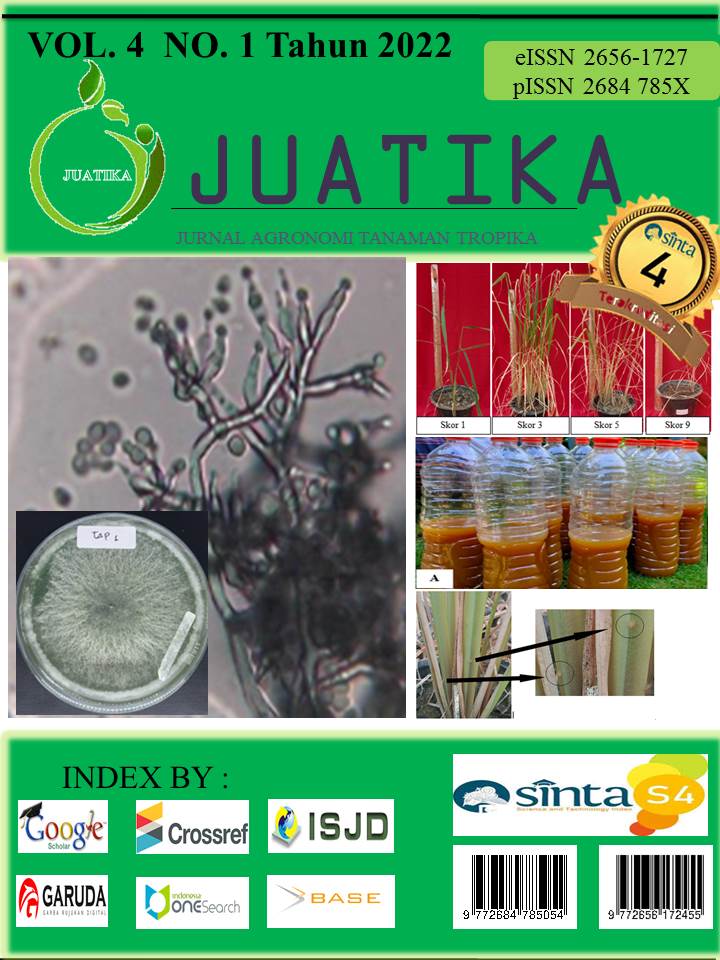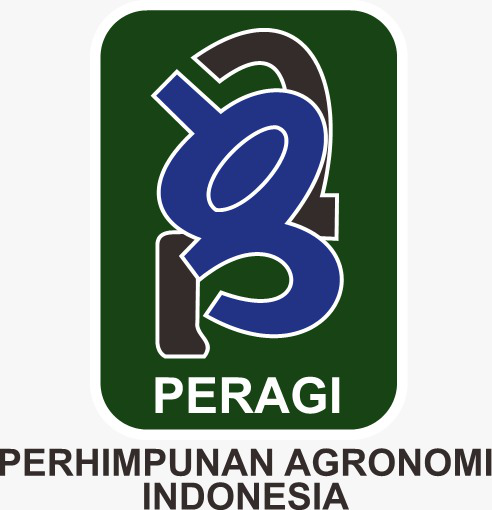Adaptation Of Sunflowers To Salinity Stress On Coastal Land
Abstract
Sunflower is one of the oil-producing plants that potentially can be developed as a food raw material, industrial, medicine, and cosmetics. Sunflower cultivation needs to be conducted in various lands in Indonesia; one of them is coastal regions. However, on one side, these lands were included on marginal land because the high level of salinity constrains it. This research aims to determine sunflower growth and thrive on salinity stress in the coastal land. This research applies a random group design with five treatments consisting of two accession and three sunflower varieties with three repetitions. The research result shows that the sunflower accession Ha1 growth and thrive on salinity stress in coastal land was quite significant compared to the accession Ha15 and Kanigara, Helina IPB, and BM1 IPB varieties. Generally, sunflower can adapt to stress salinity in coastal land.
Downloads
References
Agustian. 1994. Pengaruh Pemberian Kombinasi Fosfat Dengan Kalium Terhadap Pertumbuhan Dalam Hasil Dua Varietas Kacang Tanah (Arachis hypogea L.). Skripsi Fakultas Pertanian Universitas Syiah Kuala, Darussalam Banda Aceh.
Awas G, Abdissa T, Tolesa K, Chli A. 2010. Effect of intra row spacing on yield of three onion (Allium cepa L.) varieties at Adami Tulu Agricultural Research Center (mid rift valley of Ethiopia). J Hortic For 2: 7-11
Cahyaningrum, D.G., I.Yulianah, dan Kuswanto. 2014. Interaksi genotipe lingkungan galur-galur harapan kacang panjang (Vigna sesquipedalis L) berpolong ungu didua lokasi. Produksi tanaman. 2 (5) : 304 – 411
Cuartero,J.,M.c.bolam, Mj. Asin and V.Moreno. 2006. Increasing salt tolerance in tomato. J.Ex. Bot. 57(5):1045-1058
Djukri. 2009. Cekaman salinitas terhadap pertumbuhan tanaman. Prosiding seminar Nasional Penelitian, Pendidikan dan Penerapan MIPA. Fakultas MIPA. Universitas negeri Yogyakarta. 16 Mei 2009 : 49 – 55
Hardjowigeno, S. 2010. Ilmu Tanah. Akademia Pressindo. Jakarta.
Katja, DG. 2012. Kualitas minyak bunga matahari komersial dan hasil ektraksi biji bunga matahari (Helianthus annuus L). Jurnal ilmiah sains. 12 (1) : 59 – 64
Khotimah. 2007. Karakterisasi pertumbuhan dan perkembangan berbagai varietas bunga matahari (Helianthus annuus L.). Skripsi. Institut Pertanian Bogor, Bogor.
Latuharhary RA dan Saputro TB. 2017. Respon Morfologi Tanaman Jagung (Zea mays) Varietas Bisma dan Srikandi Kuning pada Kondisi Cekaman Salinitas Tinggi. Jurnal Sains Dan Seni Its 6 (2): 2337-3520
Lines and Kelly R 2000.Soil sense: Soil management for NSW North Coast farmers. NSW Agriculture & Land and Water Conservation, Wollongbar.
Maryati. 2004. Respon bunga matahari terhadap pupuk nitrogen dan fosfat berbagai dosis di Bandar Lampung dan Tenggamus. Disertasi. Universitas Padjajaran. Bandung
Mehran, Kesumawati E, Sufardi. 2016. Pertumbuhan dan hasil beberapa varietas bawang merah (Allium ascalonicum L) pada tanah aluvial akibat pemberian berbagai dosis pupuk NPK. J. Floratek 11 (2): 117- 133.
Munawar, A. 2011. Kesuburan Tanaman dan Nutrisi Tanaman. IPB Press. Bogor.
Munns R and M Tester. 2008. Mechanisms of salinity tolerance. Annu rev plant biol. 56: 651 – 681
Obel. Elara R Dan Jamsari. 2020. Uji Daya Adaptasi Beberapa Varietas Bawang Putih (Allium Sativum L.) Di Kabupaten Pesisir Selatan. Jur. Agroekotek 12 (2) : 152 – 164
Prasetyo I. NS Adi, A Iwan. Dan WS Pranowo. 2016. Pemetaan terumbu karang dan magrove untuk pertahanan pantai dengan menggunakan teknologi penginderaan jauh dan sistem informasi geografis ( kasus daerah biak, Papua). Chart datum. 2 (2) : 12 – 22
Qadir M, E Sudarsono, V Nangia, G Murtaza, M Singh, RJ Thomas, P Drechsel and Ad Noble. 2014. Economics of salt-induced land degradation and restoration. Natural resources forum. 38: 282 – 295
Saidah, A. Imadamayanti, Syafruddin. 2015. Pertumbuhan dan produktivitas beberapa varietas unggul baru dan lokal pada rawa melalui pengelolaan tanaman terpadu di Sulawesi Tenggara. Dalam Prosiding Seminar Nasional Masyarakat. BIODIV Indonesia. 1: 935- 940.
Sallunkhe, DK. JK Chavran. RN Adsule, dan SS Kadam. 1992. Sunflower. Pp 97-139. In world oilseed chemistry, technology and utilization. An Avi book Publ. By Van nostrand Reinhold. New York.
Sitompul, M dan B. Guritno. 1995. Analisis pertumbuhan tanaman. Gadjah Mada University Press, Yogyakarta.
Sumarni N, Rosliani R, Basuki RS. 2012. Respons pertumbuhan, hasil umbi dan serapan hara NPK tanaman bawang merah terhadap berbagai dosis pemupukan NPK pada tanah alluvial. J Hort 22 (4): 366-375
Suprapto. 1991. Bertanam Kedelai. Penebar Swadaya. Jakarta
Utama, M.Z.H.,W. Haryoko, R. Munir, Sunadi. 2009. Penapisan varietas padi toleran salinitas pada lahan rawa di Kabupaten Pesisir Selatan. J. Agron. Indonesia 37 (2) : 101-106.
Vankateswarlu, B. and R.M. Visperas. 1987. Source-Sink Relationship on Crop Plants. IRRI No. 125. 19 p
Copyright (c) 2022 Obel Obel, Silvia Permata Sari, Elara Resigia, Winda Purnama Sari Purnama Sari, Jamsari Jamsari, Ali Rahmad, Seswita Seswita

This work is licensed under a Creative Commons Attribution 4.0 International License.
Authors who publish with Jurnal Agronomi Tanaman Tropika (JUATIKA) agree to the following terms:
Authors retain copyright and grant the Jurnal Agronomi Tanaman Tropika (JUATIKA) right of first publication with the work simultaneously licensed under a Creative Commons Attribution License (CC BY 4.0) that allows others to share (copy and redistribute the material in any medium or format) and adapt (remix, transform, and build upon the material for any purpose, even commercially) with an acknowledgment of the work's authorship and initial publication in Jurnal Agronomi Tanaman Tropika (JUATIKA).
Authors are able to enter into separate, additional contractual arrangements for the non-exclusive distribution of the journal's published version of the work (e.g., post it to an institutional repository or publish it in a book), with an acknowledgment of its initial publication in Jurnal Agronomi Tanaman Tropika (JUATIKA). Authors are permitted and encouraged to post their work online (e.g., in institutional repositories or on their website) prior to and during the submission process, as it can lead to productive exchanges, as well as earlier and greater citation of published work.







 More Information
More Information



